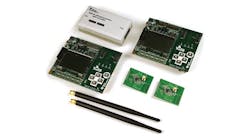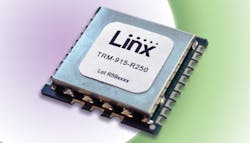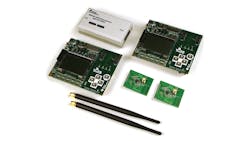Some wireless applications require longer range than Wi-Fi, Bluetooth, ZigBee, or even cellular radios can provide. The sub-1GHz unlicensed industrial, scientific, and medical (ISM) bands of 315, 433, and 902 to 928 MHz represent a great solution for some uses. Based on pure physics, these lower frequencies naturally deliver more distance than higher frequencies for a given power level, receiver sensitivity, and antenna gain. If you’re seeking a transceiver that will achieve this longer range up to several miles and want to comply with the 802.15.4g standard, you have some good options.
Semtech’s SX1272 radio frequency IC (RFIC) suits machine-to-machine (M2M) apps such as Internet of Things (IoT), Smart Grid linkage, and other remote monitoring and control connections with a maximum range up to 15 km (Fig. 1). The frequency can be set to any desired channel in the 860- to 1000-MHz range. Its maximum output power of 20 dBm (100 mW) and receiver sensitivity of –137 dBm give it a healthy 157-dB link budget.
The chip supports a wide range of modulation schemes, including frequency shift keying (FSK), Gaussian FSK (GFSK), minimum shift keying (MSK), Gaussian MSK (GMSK), on-off keying (OOK), and Semtech’s own LoRa modulation technology. The data rate is programmable up to 300 kbits/s. It operates from 1.8 to 3.7 V dc and has a low-power mode. And, it comes in a 28-pin quad flat no-lead (QFN) package. The SX1272 is available now.
The Linx Technologies’ 250 series wireless modules operate in the 902- to 928-MHz ISM band using frequency-hopping spread-spectrum (FHSS) modulation (Fig. 2). With an output power up to 23.5 dBm and a receiver sensitivity of –105 dBm, the modules are capable of a range up to 6.4 km or 4 miles. A carrier-sense multiple access (CSMA) protocol ensures a clear channel for communications.
The modules have a standard universal asynchronous receiver transmitter (UART) serial interface so they can connect to any devices using the RS-232 or RS-485 interface, making links to most microcontrollers or special peripheral devices possible. A low-power mode ensures long battery life in portable applications. Applications include wireless sensors, asset tracking, automated meter reading, and industrial or home automation.
Texas Instruments’ CC1200 SimpleLink transceiver is another good choice for sub-1-GHz applications. Directly targeting the Advanced Metering Infrastructure (AMI) and home area networks (HANs), it can be used to implement Smart Grid, home and building automation, and alarm and security system applications. Sub-1-GHz 802.15.4g radios appear to be the backhaul of choice for the utility’s link from smart meters to local concentrator hubs for data collection.
The CC1200 covers from 169 to 928 MHz with possible support for the 137- to 320-MHz range. Its +16-dBm maximum power level and –127-dBm receiver sensitivity provide an excellent link budget of 143 dB, permitting very long-range links. Data rates to 1 Mbit/s can be achieved. The IC also has superior selectivity and blocking performance for handling co-existence and interference issues in critical applications.
The CC1200 supports all of the IEEE 802.15.4g FSK modes, AES security, and all Wireless M-Bus modes. Low-power modes ensure minimal power consumption. The CC1200 is also pin-for-pin compatible with TI’s CC1120 transceiver, allowing previous users to upgrade to the new device. It comes in a 5- by 5-mm, 32-pin QFN package and costs $2.20 in 1000-unit quantities. The CC1200DK development kit is available to speed and simplify design (Fig. 3).
Linx Technologies
Semtech Corp.
Texas Instruments



